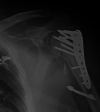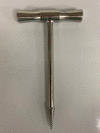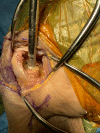The Corkscrew Technique for Removing a Fibular Strut Allograft From the Proximal Humerus
- PMID: 35449668
- PMCID: PMC9012660
- DOI: 10.7759/cureus.23233
The Corkscrew Technique for Removing a Fibular Strut Allograft From the Proximal Humerus
Abstract
A fibular strut allograft is a reliable option for augmentation in open reduction internal fixation (ORIF) of proximal humerus fractures, but techniques to remove a fibular strut during revision shoulder arthroplasty are limited. Currently published techniques on extracting fibular strut grafts from humeral shafts include using a Midas burr, flexible osteotomes, humeral shaft osteotomy, and reaming. To our knowledge there has not been a technique that uses a corkscrew to remove the fibular strut from the proximal humerus in preparation for revision shoulder arthroplasty. This is a case report and description of a simple and reproducible technique that can be implemented in the setting of conversion from a proximal humerus lateral locking plate with fibular strut allograft to shoulder arthroplasty.
Keywords: corkscrew; fibular strut allograft; lateral locking plate failure; proximal humerus fracture; revision shoulder arthroplasty.
Copyright © 2022, Skura et al.
Conflict of interest statement
The authors have declared that no competing interests exist.
Figures






References
-
- Surgical management of complex proximal humerus fractures-a systematic review of 92 studies including 4500 patients. Gupta AK, Harris JD, Erickson BJ, et al. J Orthop Trauma. 2015;29:54–59. - PubMed
-
- Epidemiology of humerus fractures in the United States: nationwide emergency department sample, 2008. Kim SH, Szabo RM, Marder RA. Arthritis Care Res (Hoboken) 2012;64:407–414. - PubMed
-
- Treatment preferences for displaced three- and four-part proximal humerus fractures. Guy P, Slobogean GP, McCormack RG. J Orthop Trauma. 2010;24:250–254. - PubMed
-
- Displaced proximal humeral fractures. II. Treatment of three-part and four-part displacement. Neer CS 2nd. https://pubmed.ncbi.nlm.nih.gov/5455340/ J Bone Joint Surg Am. 1970;52:1090–1103. - PubMed
-
- Pitfalls and complications with locking plate for proximal humerus fracture. Clavert P, Adam P, Bevort A, Bonnomet F, Kempf JF. J Shoulder Elbow Surg. 2010;19:489–494. - PubMed
